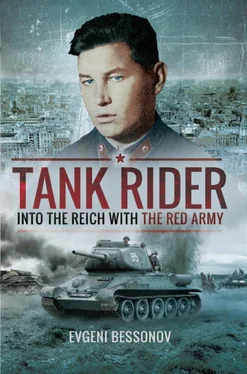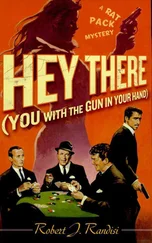On that day, 24 March, 1944, the German air force almost completely destroyed the battalion. We suffered high casualties in personnel and the tank regiment lost many tanks. The rest were not spared either. The air raids started at noon and lasted till evening. One wave of aircraft, fifteen or twenty of them, would drop their bombs, and as soon as our battalion column gathered for further advance, the next wave would arrive. This lasted for several hours, until the twilight came. ‘Luckily’, the tank that I was riding on with my platoon threw a track and we had to halt to repair it. The Brigade advanced further, but we stayed behind for the repair. It was right after the first air raid, and I did not see the other air raids on the Brigade. Having completed the repair of the track, we moved on, and two more tanks joined us on the road. We arrived at the battalion when it was already dark. I found battalion commander Kozienko and tank regiment commander Stolyarov; they were both happy to see us, a significant reinforcement. The battalion commander asked me if I had seen company leader Titov. I reported that I had not. It turned out that our company commander Petr Ivanovich Titov had disappeared, and they had been looking for him before darkness fell, searching all the area around, but failed to find him.
Soldiers of the battalion, who had previously scattered in the fields and hidden in all possible ways till darkness, started to gather at the village, which was almost totally burnt down. The battalion suffered high casualties in personnel, while the tank regiment lost a lot of tanks. In my company, except for Kolosov and myself, we had some 30 or 35 soldiers left, the other companies had even less – ten or fifteen soldiers each. Kozienko and Stolyarov gave me an order: advance on three tanks with the remains of the company and machine-gun platoon of Lieutenant Kolosov towards Kamenets-Podolsk, capture its outskirts and then act depending on the situation, but try to hold on until the main forces of the brigade arrived. They stayed behind to gather personnel and tanks after the air raids.
THE BATTLES FOR KAMENETS–PODOLSK

At dawn on 25 March, 1944, we reached Kamenets-Podolsk. Our company on three tanks bypassed the city from the west and approached the outskirts from the south. It was still dark. The Germans did not expect Soviet troops from the south, but when we approached the bridge across the Smotrich river they opened fire on us, although not very intensively. Trucks and other vehicles were parked on the bridge. It was some sort of a barricade, which even had a tank without tracks in it. The river had steep banks, up to 10 metres high, which did not allow tanks to cross the river. My attempt to enter the city over the bridge was stopped by enemy fire. The machine-gun fire did not cause any harm, but the snipers were deadly. I decided not to risk and suffer useless casualties, but rather to wait for the main forces of our Brigade to arrive. We occupied a small house not far from the bridge, and sent a scout party to the bridge. The men came back and reported that the it was impossible to bypass the barricade on the bridge, while sniper fire gave them no chance to lift their heads from the ground. While we were waiting for the main forces of the Brigade to arrive, soldiers of the company started to inspect the trucks that the Germans had abandoned as we arrived. The large trucks were filled with German uniforms, equipment, food and even wines of different kinds and countries of origin. The food and wines came from all over Europe. My men gathered German weapons and ammo, some wrapping themselves in MG-34 machinegun ammo belts – just like the seamen in the times of the Russian Civil War. What could I say – they were mere boys. Many soldiers picked up new German jackboots, but the beautiful and shining German officer long boots did not fit me – they were too tight, although I tried many of them, and I really wanted to have them. We gathered food, wine, Cuban cigars in special boxes, cigarettes, chocolate, cookies, sweet breads, canned fish and meat. We had a nice meal with all that food and smoked cigars and cigarettes. The cigars were Cuban, just like the ones that Churchill had.
The main forces of the Brigade arrived at noon. Battalion commander Kozienko called me; tank regiment commander Stolyarov was also present. I reported the situation, and the tankers also reported that the bridge was impassable and guarded by the enemy, although not in strength. The commanders ordered me to go to the right of the bridge, to try to find a crossing or a ford across Smotrich river and advance to the centre of the city. They gave me the same three tanks and, of course, Kolosov’s machine-gun platoon as a supporting unit. I was ordered to maintain communication over tank radio. I gathered the squad leaders, gave them an order to advance, and we left the area at the bridge, moving along the course of the river. Three tanks drove up to us, the company mounted them and we drove off to look for a ford or a convenient place for tanks to drive through river. We found a place that was kind of convenient, and crossed to the other bank of the river. Tankers reported to Stolyarov that we had found a ford and entered the city’s outskirts on the opposite side. However, the top of the other bank was almost vertically faced with stone, one-and-a-half metres high. The tanks could not overcome the obstacle, no matter how hard they tried. This obstacle could be called an anti-tank wall, but in reality it was built to strengthen the riverbank in case of flooding. We had to dismantle this stone wall in order to make a convenient driveway for tanks. The tankers did not have so much as a crowbar, but we somehow managed to break down the stone wall; one tank negotiated the obstacle and drove off into the city with Kolosov’s machine-gun platoon on it. The other two tanks could not get over the wall, however. We tried for a long time, but we could not do anything. Then the tank that drove into the city came back.
Lieutenant Kolosov told me that he was wounded, and I saw the fresh bandage myself. His tank had come under fire from a German machine-gun on a church bell-tower, with was almost in the centre of the city. Besides that, his tank could not move any further, as the streets were filled with trucks parked next to each other. It was not only hard to drive – it was hard to walk, so tightly were the abandoned German trucks parked. Later we learned that these trucks with all their commodities and food belonged to rear units of a large German formation that had retreated to the west. However, our Brigade cut their retreat routes and they had to stop in the city. There were very many trucks, at least 1,000 to 1,500 of them, and there were all kinds of things in them! I repeat that I never saw a larger amount of war booty anywhere else. It is interesting that there were no drivers in those trucks.
They transmitted an order over the radio for the tanks to stay put at the river, while the infantry was to advance to the railway station. It was a repetition of the earlier spoken order by the battalion commander. I advanced through the city with my company. The streets were packed with trucks, mostly heavy ones: Mahn, Opel and other types. We did not encounter the Germans – they ran away as we appeared in the city. Suddenly we heard artillery fire and shells exploding in the city. That was fire from our Brigade artillery. The company went out to the city’s outskirts, to the higher bank of Smotrich river, and we saw an interesting picture. The entire Brigade, or rather, whatever remained of it after almost a month of fighting, assaulted the city. All types of weapons fired: tanks, artillery of the Brigade’s artillery battalion, mortars and machine-guns. It was a beautiful battle scene, but it would have been nicer if they had hit the enemy, and not the friendly troops, especially my company. We shouted, waved our hats and hands (we did not have recognition colour flares), and ran around, trying to draw the attention of the assaulting troops, but it was all in vain. They continued their assault in an extended line, reached the river, waded in waist-deep in water (while my company crossed it on tanks, and we were all dry) and came up on our high bank and rushed into the city.
Читать дальше














